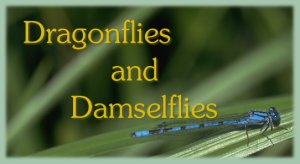

Watch these pages for information about Dragonflies and Damselflies in the UK - particularly in North Buckinghamshire. There are also pictures of dragonflies and a diary of site visits.
I n 1990, I decided to concentrate on one group of animals and try to get to know them well. All sorts of possibilities crossed my mind. Beetles? No, there are too many different sorts, thousands in the UK. Butterflies? No, everybody does them. Birds? Can't afford the telescope and the instant, drop everything trips to Fair Isle or the Scillies. After a little thought I decided to try dragonflies. I have always found them interesting to watch but didn't have a clue about identification and only knew a little about their habits and biology.
Dragonflies are probably the ideal insect to begin with to learn identification skills. There are only thirty nine breeding species and two regular migrants found in the British Isles. They are relatively large and usually brightly and distinctively coloured. They can easily be observed with the naked eye or a pair of close focus binoculars on warm summer days. I'm not saying that identification is trivially easy, many of the damselflies need close inspection to be sure of the species, but they are certainly easier to identify than, say, beetles many of which look very similar indeed.
After several years of watching dragonflies I have become reasonably competent at identifying most species. I'm not an expert, that becomes obvious when in the company of members of the British Dragonfly Society». One of the problems I found when starting serious study of dragonflies was that the books and keys available were not very easy to use. I found that I spent most of my time trying to match the observed insect against a drawing or photograph and never being 100% certain that I had got the identity correct. As only eighteen species have been recorded from Milton Keynes, I decided to try to put together a key to help others to identify these beautiful creatures.
Here is the Key to the Dragonflies of Milton Keynes mentioned above. This key has been adapted from one originally published in The Magpie», the newsletter of the Milton Keynes Natural History Society».
There are many photographs of Dragonflies and Damselflies in these pages. They have all been saved as true colour JPEGs and for best results should be viewed with at least a high colour mode setting. They will be viewable in 256 colour mode but won't look as good.







